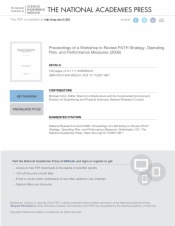Procuring Interoperability
Wang, Y. Claire; Zenooz, Ashwini; Sriram, Ram D.; Samitt, Craig; Karney, Meredith; Johnson, William; Goldman, Julian; Gettinger, Andrew; Fridsma, Douglas B.; Bono, Raquel C.; Palmer, Sezin; Johns, Michael M. E.; Pronovost, Peter...

